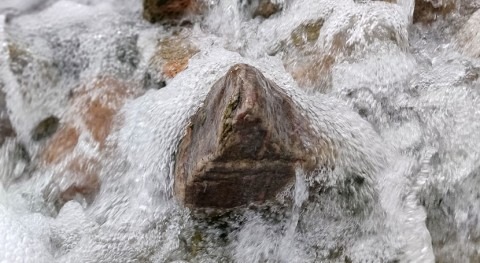Facing a diverse array of headwinds to their operations, U.S. water industry leaders are looking to accelerate innovation in strategy, operations and capital planning by harnessing digital assets and data analytics, Black & Veatch’s newly released Strategic Directions: Water Report finds. Efforts to adopt and implement technology are geared toward pushing better decision-making, optimizing and prioritizing system investments, and driving cost efficiencies that help deliver sustainability and resilience as new and traditional hurdles impact service providers.
Compounding recurring concerns about aging infrastructure assets and a graying workforce, new challenges from wildfires, floods and drought increasingly are testing the resilience of water systems. All of that lately has been against the backdrop of the global COVID-19 pandemic that halted the nation’s economy, leaving tens of millions jobless and testing the financial resilience of many providers.
Built on a survey of nearly 300 water industry leaders paired with expert analysis, the report details a transformative time as the migration toward data-driven “digital” or “smart” water technologies picks up speed, fanning the promise of everything from reliable consumption forecasts and customer engagement metrics to more robust leak detection.
Once again, the survey’s respondents cited aging water and wastewater infrastructure as the industry’s chief challenge, eclipsing such issues as justifying capital improvement programs, managing capital costs or system resilience. Saddled with doing more with less, some 15 percent of respondents report having a robust, fully integrated approach to data management, encouragingly up from just 5 percent last year. More than half say their data management is strengthening but not fully integrated, contributing to lost opportunities in optimization.
Funding is likely to become more scarce in the years ahead, so incorporating digital water to capitalize on a utility’s data is more critical than ever to ensure the greatest return on capital and operational investments - Cindy Wallis-Lage, president of Black & Veatch’s water business
“With all of the industry’s challenges, both old and new, now is the time for a broader, dedicated embrace of data to fully appreciate when, where and how much to invest in our systems,” said Cindy Wallis-Lage, president of Black & Veatch’s water business. “Funding is likely to become more scarce in the years ahead, so incorporating digital water to capitalize on a utility’s data is more critical than ever to ensure the greatest return on capital and operational investments.”
Climate change – and increasingly worrisome predictions about it – continue to grab attention among water utilities as one of their rising challenges. Adding to that is the coronavirus pandemic, which has rattled the water industry as many commercial and industrial customers – a water utility’s largest-volume consumers – were forced to temporarily halt operations, straining utilities’ revenues and cash flows. Water providers also suspended water and wastewater shutoffs to delinquent accounts.
This year’s report also details an industry migrating to a holistic, programmatic approach to challenge-solving rather than a siloed method. Digital transformation increasingly is being viewed as an integrated tool in the planning toolkit. That includes the emerging promise of innovations such as “digital twins” – integrated digital representations of physical assets that provide historical, current and predictive analysis in near real-time, simulating scenario options before actioning them.
“The water sector is at a crossroads where normal assumptions and practices are outdated, forcing the need for wider, thoughtful adoption of technology, outside-the-box thinking and longer-term planning,” said John Chevrette, president of Black & Veatch Management Consulting. “Industry leaders and other decision-making stakeholders must collaboratively strategize about everything from enhanced efficiencies and solutions to funding challenges to produce a water ecosystem that’s more responsive, abundant and secure.”
Other key findings include:
- More than half of water utilities – 56 percent of respondents – say their data-management efforts are strong and getting stronger, but not yet fully integrated.
- The vast majority of water utilities report they are collecting plenty of data. Still, only roughly 20 percent of respondents say they are leveraging it effectively for digital transformation, meaning most utilities have a long way to go in their push to optimize their utility data analytics.
- Climate change is playing a larger role in water supply planning, with 55 percent of respondents including it in their future forecasting – a shift in mindset over previous years.
- Natural or man-made disasters (nearly 84 percent) and catastrophic failure of infrastructure (56 percent) were the two most significant resilience concerns among respondents.
- Water and wastewater utilities actively are responding to mandates by conducting resilience and vulnerability assessments; more than half – 54 percent – have done so in the past year, with an additional 22 percent having carried that out in the past two to three years. This shows utilities are taking threats seriously and addressing vulnerabilities to become more resilient.
- When it comes to the confidence level of their utility’s ability to meet current and still-evolving contaminant levels established by state and federal agencies, responses varied. One-third voiced extreme confidence in their adherence to dynamic standards for various contaminants, slightly more than those who considered themselves very or moderately confident.
- Faced with the specter of climate change and increasingly extreme weather events, nearly 60 percent of respondents say water reclamation and reuse are part of their sustainability goals and metrics, demonstrating that an expanding portfolio of water reuse strategies is becoming the norm.
- One-third of respondents say their customers probably don’t understand what it takes to supply them with clean, potable water, as well as wastewater and stormwater services – making it incumbent on the utility to help them appreciate the cost involved.



















